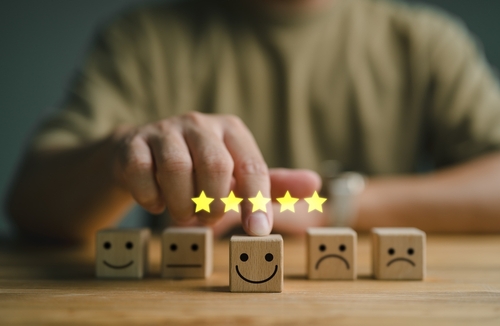In a recent discussion with the owner of a growing software business, we discussed different ways to achieve sustainable growth. He shared his satisfaction in developing a robust client base. When we discussed to what extent he was measuring the engagement of that client base, he said, “I don’t know.”
He realized his company was not adhering fully to sound practices for providing the highest level of customer experience (CX) and service (CS) leading to client retention. He then understood that his business was at risk. He began thinking about the effort it took to earn client trust and the fleeting nature of client loyalty. We then dove deep into key strategies and actions for managing a strong customer experience, culture, and function.
This five-part series continues our previously published article, “Maximizing Profits with Five Indispensable Customer Experience Practices.” This series will take a dive into the five pillars of world-class customer experience, with the aim of maximizing customer retention and business profits. Refer to the series as a comprehensive guide. The series will take a look at these five pillars:
- Fostering a customer-centric culture and mindset
- Setting customer experience goals and strategies to support your culture
- Harnessing technological innovations and the power of data
- Maximizing operational processes and employee training
- Cultivating a profit-driven continuous improvement mindset
Imagine a fitness equipment company that not only sells state-of-the-art treadmills and weights but also cultivates a community of fitness clients who feel valued and supported at every step of their journey. In this company, every interaction, from browsing the website to speaking with customer service representatives, is infused with a deep understanding of customers’ needs and a genuine desire to exceed their expectations. What sets this company apart is not just its products but its unwavering commitment to putting customers at the center of everything it does.
In today’s competitive business landscape, the importance of a customer-centric culture cannot be overstated. It’s not merely about providing excellent products or services; it’s about creating meaningful connections and experiences that keep customers coming back for more. This is where the true value lies, and it all starts with the people within the organization.
This article will explore how companies can harness the power of a customer-centric mindset and employee engagement to drive success in today’s market. Using examples and insights from various industries, we’ll delve into strategies for recruiting the right talent, fostering employee satisfaction, engaging across the business, and enhancing customer retention through personalization. Through these strategies, businesses can differentiate themselves, foster customer loyalty, and ultimately drive sustainable growth. Let’s dive in.
Recruit for Customer-Centric Mindset
Your company’s success hinges on the leadership of the people you bring on board. By prioritizing the recruitment of individuals who naturally embody a customer-centric mindset, you lay the foundation for exceptional service delivery. Seek out candidates who demonstrate empathy, strong communication skills, and a genuine passion for understanding and addressing customer needs. By infusing your workforce with these qualities, you set the stage for a culture where customer satisfaction is paramount. To recruit for a customer-centric mindset:
- Prioritize customer service excellence by clearly communicating expectations to interviewees, testing customer service skills for all positions, and emphasizing high standards in job ads.
- Demonstrate a proactive approach to talent acquisition by consistently seeking out and hiring top talent, rather than solely during staff shortages.
- Allocate sufficient resources to ensure a positive candidate experience, including responsive communication, transparent processes, and adequate budgeting.
Emphasize Employee Engagement and Satisfaction
Engaged and satisfied employees are the linchpin of a customer-centric culture. When your workforce feels valued and supported, they are more likely to go above and beyond to satisfy customers. Invest in initiatives that foster a positive work environment, promote open communication, and recognize employee contributions. By prioritizing employee well-being, you create a ripple effect that translates into elevated customer satisfaction levels and increased loyalty. To emphasize employee engagement and satisfaction:
- Prioritize employee development and satisfaction by offering clear career paths, investing in skill development, and providing cross-training opportunities.
- Engage actively with employees through regular check-ins, satisfaction surveys, and anonymous feedback channels to ensure their voices are heard and valued.
- Demonstrate a commitment to employee well-being and recognition through compensation above industry standards, managerial support, and an implemented recognition and reward system, while providing an optimal workplace infrastructure.
Actively Engage Across the Business
True customer-centricity requires the involvement of every employee, regardless of their role within the organization. Encourage a culture where every employee is properly trained to contribute to the customer experience. Whether it’s the frontline staff interacting directly with customers or back-office personnel supporting internal processes, everyone has a role to play in delivering exceptional service and satisfaction. Foster cross-functional collaboration to ensure that every touchpoint reinforces your commitment to the customer. To actively engage across the business:
- Define a strategy to continually shift its culture toward customer-centricity.
- Display publicly real-time customer satisfaction scores, response time targets, and performance metrics for all employees.
- Ensure that every employee, regardless of their role, undergoes comprehensive training in customer-centricity.
Enhance Customer Retention Through Personalization
Building lasting relationships with customers goes beyond transactional interactions. It’s about understanding their unique needs, preferences, and pain points. Your company should prioritize customer retention by profiling the value and loyalty of each client. Use data-driven insights to tailor your approach, addressing individual needs, and making the most of the overall experience. By personalizing interactions and proactively addressing customer concerns, you reinforce loyalty and drive long-term profitability. To enhance customer retention:
- Establish metrics to measure customer loyalty.
- Use a scoring system to determine into which loyalty segment customers fall.
- Tailor interactions with customers based on their loyalty segment.
At the end of the day, a “customer-centric culture” is not just a catchphrase; it’s a strategic imperative for business success. This is exactly the mindset our fitness equipment company applied with great success. By recruiting for mindset, prioritizing employee engagement, fostering cross-functional collaboration, enhancing customer retention through personalization, and embracing continuous culture transformation, your company can differentiate itself in a crowded marketplace. Stay tuned for our next article, where we’ll delve into the strategic dimensions of setting clear customer experience goals and strategies to support your culture.
Enhance your customer experience journey by completing our complimentary CX Function Index Survey. Upon completion, connect with us to receive a comprehensive evaluation of your CX function’s performance, including individual scores for the five strategic dimensions of a world-class CX function.





